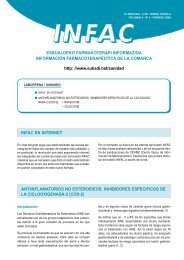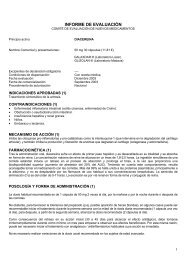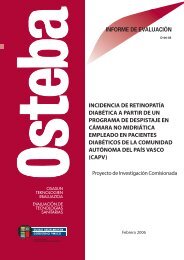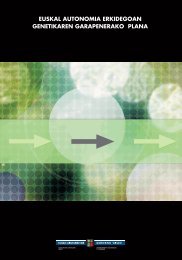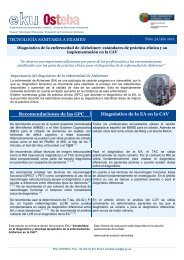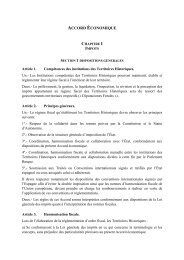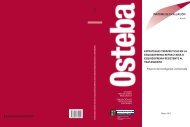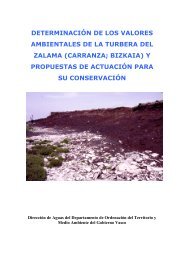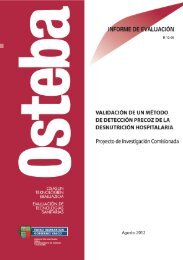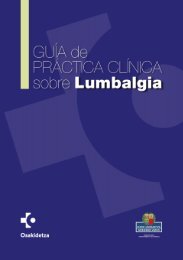Estudio de la diversidad de aves paseriformes migradoras e ...
Estudio de la diversidad de aves paseriformes migradoras e ...
Estudio de la diversidad de aves paseriformes migradoras e ...
Create successful ePaper yourself
Turn your PDF publications into a flip-book with our unique Google optimized e-Paper software.
ESTUDIO DE LA DIVERSIDAD DE AVES PASERIFORMES MIGRADORAS E INVERNANTES EN EL PARQUE<br />
ECOLÓGICO DE PLAIAUNDI (TXINGUDI, GIPUZKOA) – 2003<br />
Juan Arizaga Martínez & Daniel Alonso Urmeneta<br />
SOCIEDAD DE CIENCIAS ARANZADI ZIENTZI ELKARTEA<br />
INTRODUCCIÓN<br />
La Estación <strong>de</strong> Anil<strong>la</strong>miento <strong>de</strong> <strong>la</strong> Sociedad <strong>de</strong> Ciencias Naturales Aranzadi está<br />
llevando a cabo un proyecto <strong>de</strong> investigación titu<strong>la</strong>do “estudio <strong>de</strong> <strong>la</strong> <strong>diversidad</strong> <strong>de</strong> <strong>aves</strong><br />
<strong>paseriformes</strong> migratorias e invernantes en el Parque Ecológico <strong>de</strong> P<strong>la</strong>iaundi (Txingudi,<br />
Gipuzkoa)”. Los objetivos <strong>de</strong> este trabajo se resumen en los siguientes puntos:<br />
1. Conocer <strong>la</strong> <strong>diversidad</strong> y <strong>la</strong> fenología <strong>de</strong> los <strong>paseriformes</strong> migratorios y/o<br />
invernantes en el Parque Ecológico <strong>de</strong> P<strong>la</strong>iaundi.<br />
2. Conocer <strong>la</strong> abundancia <strong>de</strong> los <strong>paseriformes</strong> migrotorios y/o invernantes en el<br />
Parque Ecológico <strong>de</strong> P<strong>la</strong>iaundi, y su variación a lo <strong>la</strong>rgo <strong>de</strong>l tiempo. Conocer,<br />
por tanto, cuáles son <strong>la</strong>s especies dominantes y <strong>la</strong>s especies raras, a lo <strong>la</strong>rgo<br />
<strong>de</strong>l tiempo.<br />
3. Conocer <strong>la</strong> re<strong>la</strong>ción entre <strong>la</strong>s especies <strong>de</strong> <strong>paseriformes</strong> migratorios y/o<br />
invernantes en el Parque Ecológico <strong>de</strong> P<strong>la</strong>iundi y los biotopos presentes en el<br />
área <strong>de</strong> estudio.<br />
4. Evaluar <strong>la</strong> importancia <strong>de</strong>l Parque Ecológico <strong>de</strong> P<strong>la</strong>iaundi para <strong>la</strong>s <strong>aves</strong><br />
<strong>paseriformes</strong> migratorias y/o invernantes.<br />
5. Contribuir al <strong>de</strong>sarrollo <strong>de</strong> <strong>la</strong> Estación Ornitológica <strong>de</strong> <strong>la</strong> Sociedad <strong>de</strong> Ciencias<br />
Naturales Aranzadi.<br />
MATERIALES Y MÉTODOS<br />
Lugares <strong>de</strong> muestreo y Periodicidad <strong>de</strong> muestreo<br />
Durante 2003, el estudio ha sido realizado en el Parque Ecológico <strong>de</strong> P<strong>la</strong>iaundi (Irún,<br />
Gipuzkoa). Esta área es utilizada por varias especies <strong>de</strong> <strong>aves</strong> <strong>paseriformes</strong> como lugar<br />
<strong>de</strong> <strong>de</strong>scanso durante su migración hacia y <strong>de</strong>s<strong>de</strong> los cuarteles <strong>de</strong> invierno, en <strong>la</strong><br />
Cuenca Mediterránea o en África, así como área <strong>de</strong> invernada.<br />
El estudio comenzó el 15 <strong>de</strong> agosto <strong>de</strong> 2003 y el esfuerzo <strong>de</strong> muestreo ha tenido una<br />
periodicidad <strong>de</strong> una vez por semana.<br />
Metodología<br />
Se contempló <strong>la</strong> captura, marcaje y puesta en libertad <strong>de</strong> un elevado número <strong>de</strong> <strong>aves</strong>.<br />
Para ello se emplearon re<strong>de</strong>s japonesas verticales. A cada ejemp<strong>la</strong>r se le tomaron <strong>la</strong>s<br />
siguientes variables: sexo, edad (código EURING), longitud <strong>de</strong>l a<strong>la</strong>, primarias, co<strong>la</strong>,<br />
culmen y tarso; grasa subcutánea acumu<strong>la</strong>da, peso. El marcaje se realizó con anil<strong>la</strong>s<br />
metálicas convencionales, proporcionadas por <strong>la</strong> Oficina <strong>de</strong> Anil<strong>la</strong>miento <strong>de</strong> <strong>la</strong><br />
Sociedad <strong>de</strong> Ciencias Aranzadi.<br />
EQUIPO DE TRABAJO<br />
La realización <strong>de</strong>l trabajo fue realizada por Juan Arizaga Martínez y Daniel Alonso<br />
Urmeneta. Por este motivo, los resultados aquí presentados incluyen los datos <strong>de</strong><br />
anil<strong>la</strong>miento <strong>de</strong> ambos Anil<strong>la</strong>dores Expertos, reconocidos y ava<strong>la</strong>dos por el Centro <strong>de</strong><br />
Migración <strong>de</strong> Aves <strong>de</strong> <strong>la</strong> Sociedad Españo<strong>la</strong> <strong>de</strong> Ornitología y <strong>la</strong> Oficina <strong>de</strong> Anil<strong>la</strong>miento<br />
<strong>de</strong> <strong>la</strong> Sociedad <strong>de</strong> Ciencias Naturales Aranzadi.
ESTUDIO DE LA DIVERSIDAD DE AVES PASERIFORMES MIGRADORAS E INVERNANTES EN EL PARQUE<br />
ECOLÓGICO DE PLAIAUNDI (TXINGUDI, GIPUZKOA) – 2003<br />
Juan Arizaga Martínez & Daniel Alonso Urmeneta<br />
SOCIEDAD DE CIENCIAS ARANZADI ZIENTZI ELKARTEA<br />
RESULTADOS<br />
A continuación se presenta una tab<strong>la</strong>-resumen <strong>de</strong> <strong>la</strong>s capturas a lo <strong>la</strong>rgo <strong>de</strong> 2003. No<br />
se incluyen <strong>la</strong>s recapturas propias producidas durante este mismo período.<br />
Especie Total<br />
Acrocephalus schoenobaenus 19<br />
Acrocephalus scirpaceus 160<br />
Actitis hypoleucos 1<br />
Aegithalos caudatus 25<br />
Alcedo atthis 10<br />
Anthus pratensis 2<br />
Carduelis carduelis 3<br />
Carduelis chloris 2<br />
Carduelis spinus 2<br />
Certhia brachydacty<strong>la</strong> 1<br />
Cettia cetti 19<br />
Cistico<strong>la</strong> juncidis 1<br />
Delichon urbica 3<br />
Emberiza schoeniclus 3<br />
Erithacus rubecu<strong>la</strong> 76<br />
Ficedu<strong>la</strong> hypoleuca 9<br />
Fringil<strong>la</strong> coelebs 1<br />
Hippo<strong>la</strong>is polyglotta 3<br />
Lanius collurio 7<br />
Locustel<strong>la</strong> naevia 1<br />
Luscinia megarhynchos 2<br />
Luscinia svecica 3<br />
Motacil<strong>la</strong> cinerea 1<br />
Muscicapa striata 5<br />
Parus caeruleus 8<br />
Parus major 6<br />
Passer domesticus 18<br />
Passer montanus 5<br />
Phoenicurus phoenicurus 1<br />
Phylloscopus collybita 67<br />
Phylloscopus ibericus 2<br />
Phylloscopus trochilus 54<br />
Prunel<strong>la</strong> modu<strong>la</strong>ris 7<br />
Regulus ignicapillus 5<br />
Remiz pendulinus 5<br />
Saxico<strong>la</strong> rubetra 3<br />
Sturnus vulgaris 1<br />
Sylvia atricapil<strong>la</strong> 10<br />
Sylvia borin 5<br />
Sylvia communis 5<br />
Troglodytes troglodytes 2<br />
Turdus meru<strong>la</strong> 13
ESTUDIO DE LA DIVERSIDAD DE AVES PASERIFORMES MIGRADORAS E INVERNANTES EN EL PARQUE<br />
ECOLÓGICO DE PLAIAUNDI (TXINGUDI, GIPUZKOA) – 2003<br />
Juan Arizaga Martínez & Daniel Alonso Urmeneta<br />
SOCIEDAD DE CIENCIAS ARANZADI ZIENTZI ELKARTEA<br />
Turdus philomelos 3<br />
Total general 579<br />
A continuación se presenta una tab<strong>la</strong>-resumen <strong>de</strong> <strong>la</strong>s recapturas no propias realizadas<br />
durante 2003.<br />
Especie Anil<strong>la</strong> Inscripción<br />
País <strong>de</strong><br />
Origen<br />
Acrocephalus scirpaceus P283594 BRIT. MUSEUM LONDON S.W.7 Gran Bretaña<br />
Acrocephalus scirpaceus R865063 BRIT. MUSEUM LONDON S.W.7 Gran Bretaña<br />
Acrocephalus scirpaceus A221779 BUDAPEST Hungría<br />
Erithacus rubecu<strong>la</strong> L747324 MIN MED AMB ICONA-MADRID España<br />
Phylloscopus collybita BE1480 MIN MED AMB ICONA-MADRID España<br />
Phylloscopus collybita SF3267 4 MUSEUM BRUXELLES Bélgica<br />
Turdus meru<strong>la</strong> 3243367 MINISTERIO MEDIO AMBIENTE ICONA MADRID SPAIN España<br />
Así mismo, se presentó una comunicación oral titu<strong>la</strong>da “Fenología <strong>de</strong> <strong>la</strong> migración<br />
postnupcial <strong>de</strong> los <strong>paseriformes</strong> en el Parque Ecológico <strong>de</strong> P<strong>la</strong>iaundi (Txingudi,<br />
Guipúzcoa), en <strong>la</strong>s IV Jornadas Cantábricas Ornitológicas celebradas en P<strong>la</strong>iaundi <strong>de</strong>l<br />
6 al 8 <strong>de</strong> diciembre <strong>de</strong> 2003 (Ver Anexo).<br />
PLAN DE TRABAJO DE 2004<br />
No se preven cambios sustanciales en el p<strong>la</strong>n <strong>de</strong> trabajo para el 2004. El trabajo <strong>de</strong><br />
investigación está previsto que finalice el 15 <strong>de</strong> mayo <strong>de</strong> 2004 una vez el período <strong>de</strong> <strong>la</strong><br />
migración prenupcial haya concluido (<strong>de</strong> este modo se completará <strong>la</strong> toma <strong>de</strong> datos<br />
re<strong>la</strong>tivos a un ciclo <strong>de</strong> migración postnupcial-invernada-migración prenupcial). Así<br />
mismo, se tiene previsto continuar con este proyecto en <strong>la</strong>s próximas migraciones<br />
post- y prenupciales e invierno <strong>de</strong> 2004-2005.<br />
Se continuará en el mismo lugar <strong>de</strong> muestreo y con <strong>la</strong>s mismas periodicidad y<br />
metodología <strong>de</strong>sarrol<strong>la</strong>das durante 2003.<br />
DATOS PERSONALES<br />
Juan Arizaga Martínez, DNI 72483037<br />
Departamento <strong>de</strong> Zoología y Ecología<br />
Facultad <strong>de</strong> Ciencias, Universidad <strong>de</strong> Navarra<br />
Apdo. 177 E-31080 Pamplona<br />
Tel.: 948 425600 ext. 6281<br />
E-mail: jarizaga@alumni.unav.es<br />
Daniel Alonso Urmeneta, DNI 15808724<br />
San Juan Bosco 13, bajo-trasera<br />
E-31007 Pamplona<br />
Tel.: 948 262811<br />
E-mail: loxiadaniel@loxiadaniel.com
ESTUDIO DE LA DIVERSIDAD DE AVES PASERIFORMES MIGRADORAS E INVERNANTES EN EL PARQUE<br />
ECOLÓGICO DE PLAIAUNDI (TXINGUDI, GIPUZKOA) – 2003<br />
Juan Arizaga Martínez & Daniel Alonso Urmeneta<br />
SOCIEDAD DE CIENCIAS ARANZADI ZIENTZI ELKARTEA<br />
ANEXO: Resumen <strong>de</strong> <strong>la</strong> comunicación oral presentada en <strong>la</strong>s IV Jornadas Cantábricas<br />
Ornitológicas (6 a 8 <strong>de</strong> diciembre <strong>de</strong> 2003).<br />
FENOLOGÍA DE LA MIGRACIÓN POSTNUPCIAL DE LOS PASERIFORMES<br />
EN EL PARQUE ECOLÓGICO DE PLAIAUNDI (TXINGUDI, GUIPÚZCOA)<br />
Juan Arizaga 1,2 , Daniel Alonso 3<br />
1 Departamento <strong>de</strong> Zoología y Ecología, Universidad <strong>de</strong> Navarra, Apdo. 177 E-<br />
31080 Pamplona. 2 Contacto: jarizaga@alumni.unav.es<br />
3 San Juan Bosco 13, bajo izda. E-31080 Pamplona.<br />
Cada año, tras <strong>la</strong> época reproductora, millones <strong>de</strong> <strong>aves</strong> se <strong>de</strong>sp<strong>la</strong>zan <strong>de</strong>s<strong>de</strong><br />
sus áreas <strong>de</strong> cría hacia los cuarteles <strong>de</strong> invierno, en un fenómeno <strong>de</strong>nominado<br />
migración postnupcial. Una <strong>de</strong> <strong>la</strong>s principales rutas migratorias que <strong>la</strong>s <strong>aves</strong><br />
realizan en el Paleártico Occi<strong>de</strong>ntal recorre <strong>la</strong> costa atlántica <strong>de</strong> Europa,<br />
uniendo <strong>la</strong>s áreas <strong>de</strong> cría, en el norte y el centro <strong>de</strong>l continente, con los<br />
cuarteles <strong>de</strong> invierno, en <strong>la</strong> Cuenca Mediterránea o África. En esta ruta, el<br />
entorno <strong>de</strong> <strong>la</strong> <strong>de</strong>sembocadura <strong>de</strong>l río Bidasoa (Txingudi) constituye un área <strong>de</strong><br />
especial interés que, por su posición geográfica estratégica y sus<br />
características ecológicas, es utilizada por muchas especies <strong>de</strong> <strong>aves</strong> para<br />
<strong>de</strong>scansar y alimentarse durante su migración. A pesar <strong>de</strong> que Txingudi ha sido<br />
<strong>de</strong>c<strong>la</strong>rado humedal <strong>de</strong> importancia internacional (RAMSAR), hasta <strong>la</strong> fecha<br />
ningún estudio <strong>de</strong> carácter general re<strong>la</strong>cionado con <strong>la</strong> fenología <strong>de</strong> <strong>la</strong> migración<br />
<strong>de</strong> <strong>la</strong>s <strong>aves</strong> <strong>paseriformes</strong> ha sido realizado en <strong>la</strong> zona. Por esta razón se<br />
<strong>de</strong>cidió llevar a cabo el proyecto “<strong>Estudio</strong> <strong>de</strong> <strong>la</strong> <strong>diversidad</strong> <strong>de</strong> <strong>aves</strong> <strong>paseriformes</strong><br />
<strong>migradoras</strong> e invernantes en el Parque Ecológico <strong>de</strong> P<strong>la</strong>iaundi (Txingudi,<br />
Gipuzkoa)”, entre cuyos objetivos principales se encuentra el conocimiento <strong>de</strong><br />
<strong>la</strong> fenología <strong>de</strong> <strong>la</strong> comunidad <strong>de</strong> <strong>aves</strong> <strong>paseriformes</strong> migratorias e invernantes<br />
en el área <strong>de</strong> estudio.<br />
El presente trabajo se <strong>de</strong>sarrolló en el Parque Ecológico <strong>de</strong> P<strong>la</strong>iaundi (Irún)<br />
durante el paso migratorio postnupcial (15 Agosto-31 <strong>de</strong> Octubre). Se<br />
colocaron 72 metros <strong>de</strong> re<strong>de</strong>s japonesas verticales, en 5 biotopos diferentes,<br />
durante <strong>la</strong>s dos horas anteriores al ocaso hasta el anochecer, una vez por<br />
semana. En total se capturaron 543 <strong>aves</strong> que fueron anil<strong>la</strong>das (o se leyó <strong>la</strong><br />
anil<strong>la</strong>), se <strong>de</strong>terminó su sexo y edad (cuando fue posible) y se tomaron datos<br />
biométricos.<br />
La especie más abundante fue el Carricero Común (Acrocephalus scirpaceus)<br />
hasta <strong>la</strong> décima semana <strong>de</strong> muestreo (segunda <strong>de</strong>cena <strong>de</strong> octubre), a partir <strong>de</strong><br />
<strong>la</strong> cual fue sustituida por el Petirrojo (Erithacus rubécu<strong>la</strong>); este mismo patrón se
ESTUDIO DE LA DIVERSIDAD DE AVES PASERIFORMES MIGRADORAS E INVERNANTES EN EL PARQUE<br />
ECOLÓGICO DE PLAIAUNDI (TXINGUDI, GIPUZKOA) – 2003<br />
Juan Arizaga Martínez & Daniel Alonso Urmeneta<br />
SOCIEDAD DE CIENCIAS ARANZADI ZIENTZI ELKARTEA<br />
repitió consi<strong>de</strong>rando <strong>la</strong>s especies migratorias trans- y presaharianas. Durante<br />
todo el período <strong>la</strong> familia Sylviidae fue dominante y el biotopo más utilizado fue<br />
el carrizal (Phragmites australis).



